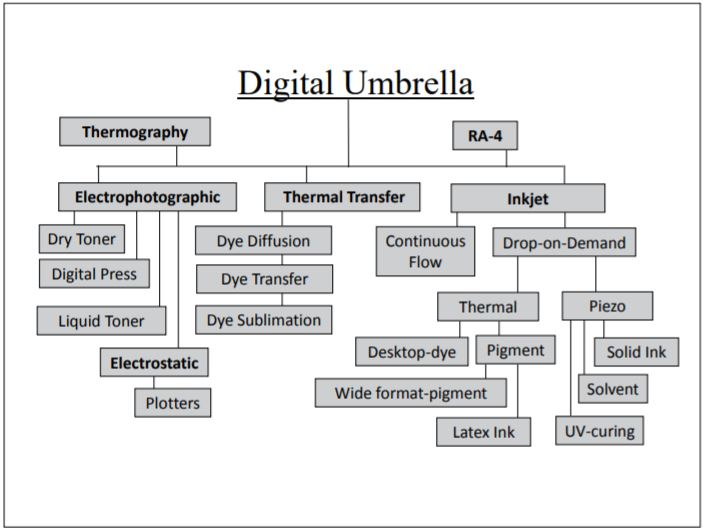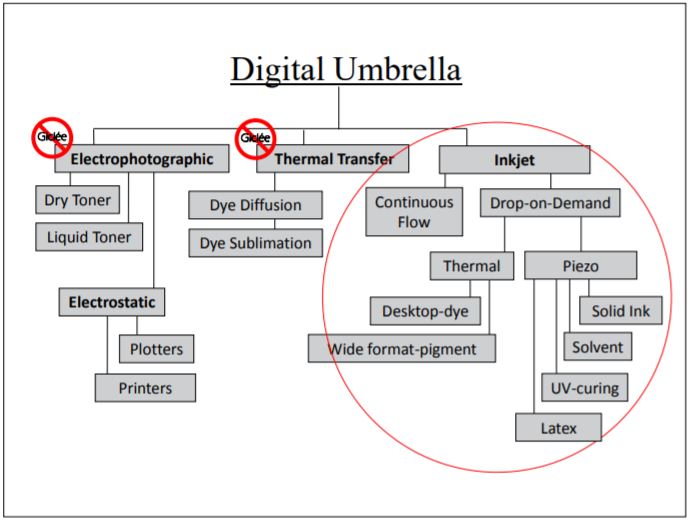
As I reviewed my past articles on the development of digitals I noticed they concentrated on photographs and the demise of traditional photo industry. The shift from analog film to digital formatting, as well as film developing to posting images and videos on social media within seconds of filming has changed everything. I have said many times that digital is here to stay, but little did I realize how it would greatly it would impact our lives, personally and as framers.
Where dye sublimation and RA4 developing has replaced traditional darkrooms, wide format inkjet printing of print-on-demand (POD) reproductions have made open edition offset lithography an antiquated process. Digital imagery now dominates all aspects of the printing world from sign and display to fine art. And although digital printing includes all types of printing from color copies on plain paper to solvent inkjet exterior building wraps on vinyl (see Digital Umbrella chart) framers need to understand their limitations when dealing with this media.

Inkjet
Inkjet is only one aspect of digitals. Though photos are printed as inkjet images too they dominate the thermal transfer technologies of dye sublimation and dye diffusion. Inkjet breaks into continuous flow and drop-on-demand (DOD) encompassing thermal and piezo technologies. There is a vast handling difference between a high end, fine art giclée and a desktop printed digital photograph or greeting card.
Desktop dye base thermal and pigment piezo; solid ink; wide format waterborne, solvent, latex, and UV-curing are all current inkjet technologies but all have very different end product dynamics. Dyes seep into the paper substrate more easily than pigments, which primarily sit up on the surface of the paper. Ink manufacturers continue to improve ink chemistry allowing dye base inks to much brighter and have a wider color range of color matching than pigmented inks. In contrast, pigmented inks are more lightfast and colorfast giving them a longer lifespan. Current media for inkjet printing run the gamut from plain paper to photo paper to fine art paper to canvas to building wrap mesh and everything between.
Thermal vs. Piezo
Thermal technology—Canon, HP DesignJet, HP PhotoSmart, Lexmark—prints to plain paper, photo paper, light coated paper and uses dye-based inks. Large format thermal printers that use pigmented inks will print to canvas, photo, film, polypropylene, Tyvek, textured & coated paper and include HP DesignJet 4500, 4500, Z series 3100, 6100, Canon image PROGRAF iPF series, Kodak Encad NovaJet. HP DesignJet 25500 is a wide format thermal printer for latex ink.
Piezo technology uses pigmented inks and is used for both fine art and commercial printing. Wide format fine art printers include Epson Stylus Pro 9880 and Roland while commercial wide format include Epson Stylus Pro 9900, Mutoh Falcon II, and Mimaki JV4.
Archival Inks
Archival ink may be is pigment or solvent-based and archival media includes photo paper, watercolor paper, canvas, or artist textured vinyl. Dye-base inks are used with thermal printers—HP—and the archival quality version have excellent color gamut and are molecularly soluble in water. Pigmented inks are common for piezo printers—Epson, HP-Z series, Canon—archival ink excels in permanence, is not molecularly soluble but is embed into the receiving layer making them water-resistant and less susceptible to destructive environmental elements. Many digital papers have coatings which enhance color gamut, making them susceptible to scuffing and scratching which diminishes the archival properties of the print. Prints made with coated substrates are not considered true digital pigment prints.
Use of archival quality inks alone does not qualify an image as a giclée. It is the combination of ink, printer and media that establishes its giclée standing.

Giclée vs. Inkjet
Simply put, all giclée are inkjet, but not all inkjet are giclée. giclée is a marketing term coined by the developers of the first continuous tone technology of the IRIS printer taken over by Scitex, now owned by HP—developed in the late 1980s. It was a revolutionary printing process that launched the digital world and has brought us to where we are today. IRIS printers were originally developed to produce proofs from digital files where color matching was critical such as in product packaging and magazine publication where they were used to verify colors prior to production. By 2010 the IRIS printer had been replaced in the fine art industry by Epson and other large-format printers that feature more archival inks and were more economical than the original IRIS. Today's giclée may be printed on any media, from canvas to watercolor paper to acrylic. They are superior to traditional lithography producing brighter colors, longer lasting inks, and have such high-resolution that virtually qualify as continuous tone.
Giclée fine art images are digital, color calibrated, wide-format printed to fine art paper, silk, canvas, bamboo, acrylic and aluminum. They evolved from a proofing system for traditional lithographic printing presses when it became apparent that the presses were having a hard time delivering the equivalent end product image quality and brilliant color of the giclée proofs. Giclée images are generally individually produced as high-resolution, high-fidelity, high-tech reproductions using CMYK+, produced on special large format pigment ink printers using only high-gamut, moisture-resistant, inks. Printers include IRIS—Scitex, Canon PROGRAF iPF series, HP DesignJet 4500, 4500, Z series 3100, 6100 and Epson Stylus Pro 9880 and 9900.
Solvent Inkjet
Solvent inks allow for printing on a wider range of substrates than water-base dye or pigment inks. They are also more durable and lightfast when used for exterior signage. Since these inks are composed of pigments held within a liquid base of solvents, they are more difficult to work with and require more care than aqueous inks. In addition, there are now eco-solvent inks that are more eco-friendly but cannot be printed on as wide a range of surfaces as traditional solvent based inks.
Wide format solvent printers are used for commercial output such as wraps and exterior signage. They do not require special coatings because they are already waterproof, durable and resistant to UV light but are heat sensitive to dry mounting 150ºF and over. Solvent printers include Epson Stylus Pro GS6000, Roland VersaCAMM, HP Scitex LX600 (formerly HP DesignJet L65500), and Mutoh ValueJet. HP DesignJet 8000s and 9000s were developed for commercial wide format printing of exterior images to withstand rigors of weather.
Though solvent printers were developed for commercial purposes, that does not mean art images are never printed with solvent inks. Solvent printers are currently being used by fine art publishers for print-on-demand (POD) open edition images printed onto canvas media. That said, they may not meet the criteria to be called fine art giclée so framing them using non-preservation methods including dry mounting are totally acceptable.
UV Inkjet
UV inkjet may be printed onto a wide variety of substrates both porous and non-porous. They are durable and lightfast, so you can use them for exterior signage without needing to laminate the prints. The ink is composed of colored pigments mixed into a synthetic resin for printing large format graphics. Ultraviolet light cures the inks by polymerizing—changing their chemical composition—and bonding them to the substrate of choice.
Wide format and super wide printers that use UV-curing inks are designed for commercial use and print to glass, acrylic, corrugated board, honeycomb panels, foamboard, polycarbonate and aluminum composite material (ACM). Agfa, Durst, HP Scitex, Mimaki and Mutoh are among the UV-curing manufacturers.
Latex Inkjet
Latex inks are aqueous, pigmented inks durable for interior and exterior use, and they do not need to be laminated.
Latex inkjet was developed and released by HP in 2008 using aqueous pigment particles in the ink. Latex inks are also flexible and stretchable, which makes them good for vehicle wraps and other applications over a base that is not absolutely flat including fabric signage. They are also good for back-lit signage, point-of-purchase displays, or for any application appropriate for low-solvent inks.
The moisture in the ink evaporates bonding the latex particles into a durable film resulting in a dry, ready-to-use vinyl or flexible sign. Inks are lightfast for indoor, in-window and outdoor display and are scratch, smudge and water-resist. Latex printers use internal radiant heaters and forced airflow to cure inks during the printing process. Wide format printers inckude HP DesignJet L25500, L26500, HP Scitex LX6001, HP Scitex LX800 Printers, Mimaki JV400-130LX and JV400-160LX.
Final Wrap
True to form the digital technologies the information included in this article is valid for the day it was written and new technologies and printing media are launched all the time. As quickly as a digital photo is posted to a social network and soon becomes yesterday's hot item, what is current a current digital technology today could be altered, updated or outdated tomorrow.
For more discussion on current digital trends and updates don't miss my new digital class at WCAF this year, Digital Trends and Handling Them, 2015.
END
Copyright © 2015 Chris A Paschke
For more articles on mounting basics look under the mounting section in Articles by Subject.
Additional information on all types of mounting is found in:
The Mounting and Laminating Handbook, Second Edition, 2002,
The Mounting And Laminating Handbook, Third Edition, 2008 and
Creative Mounting, Wrapping, And Laminating, 2000 will teach you everything you need to know about getting the most from your dry mount equipment and materials as an innovative frame designer.
All books are available from Designs Ink Publishing through this website.
Chris A Paschke, CPF GCF
Designs Ink
Designs Ink Publishing
785 Tucker Road, Suite G-183
Tehachapi, CA 93561
P 661-821-2188
chris@designsinkart.com